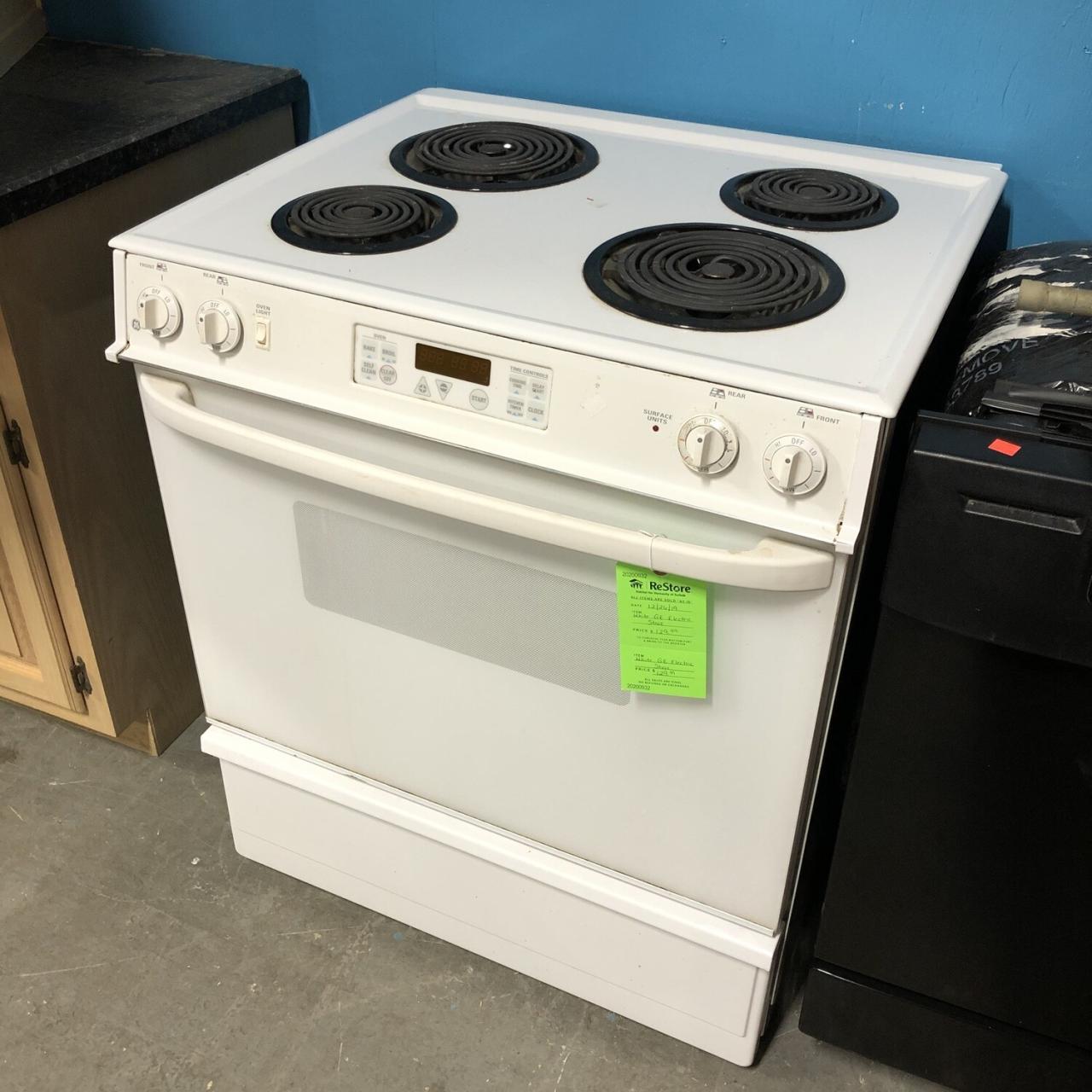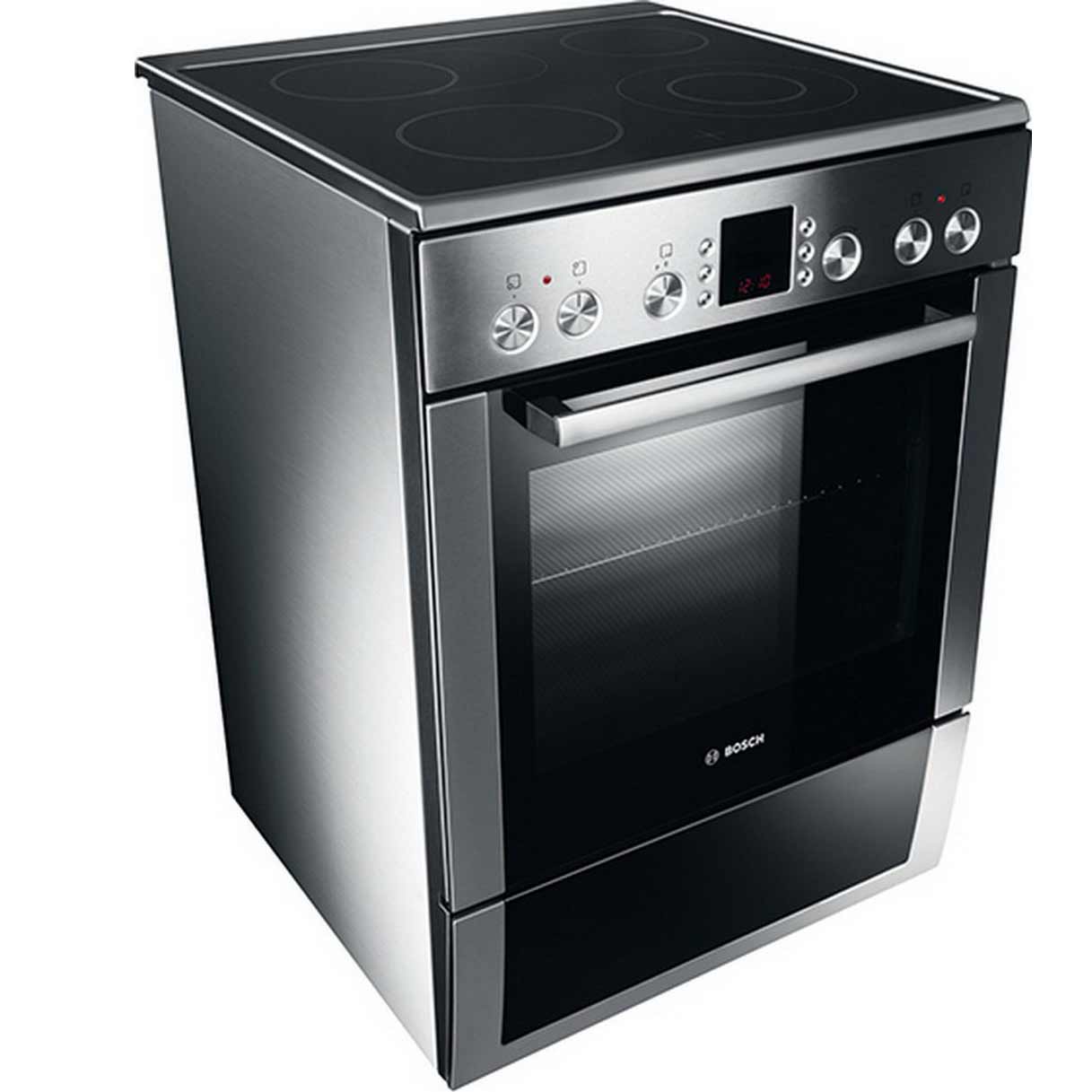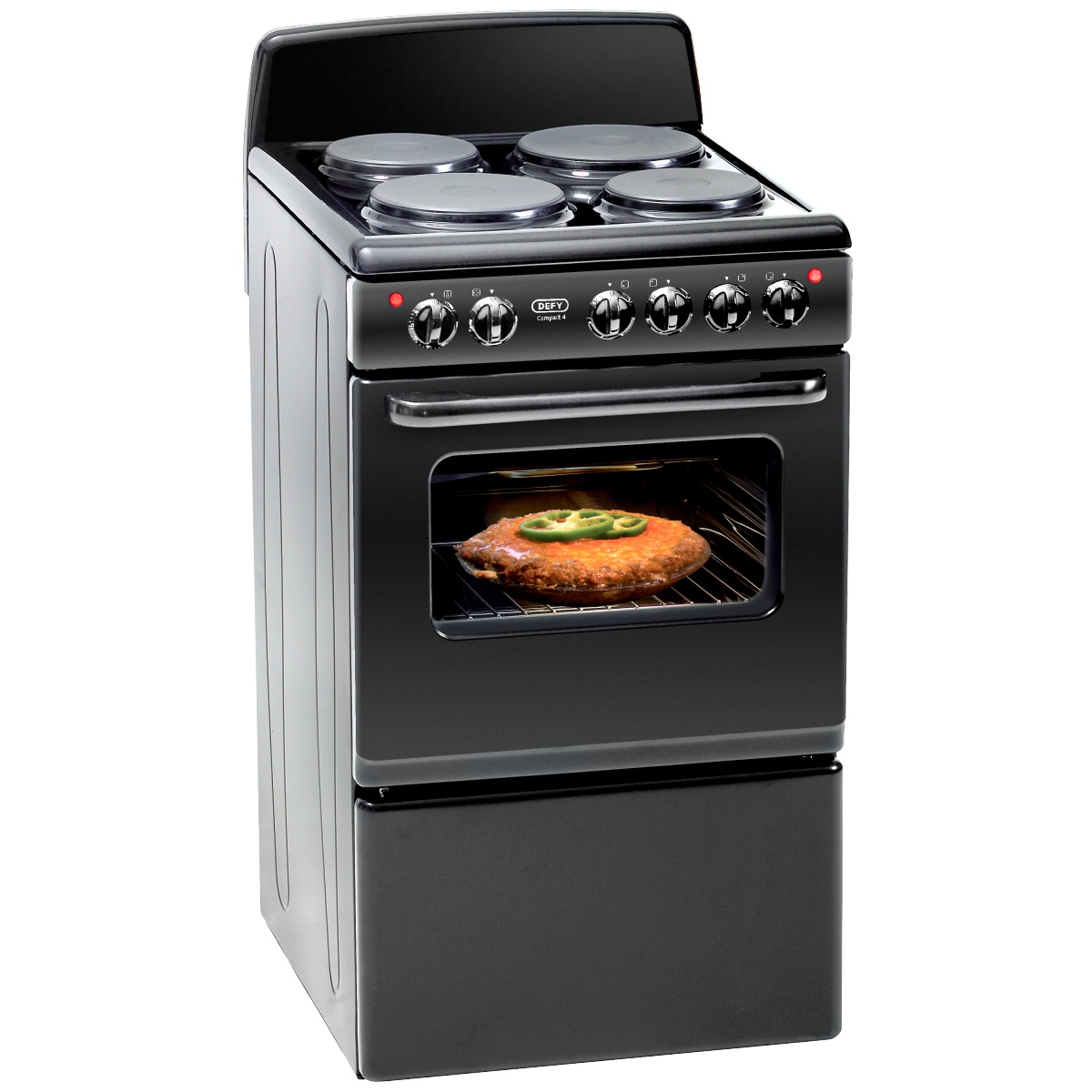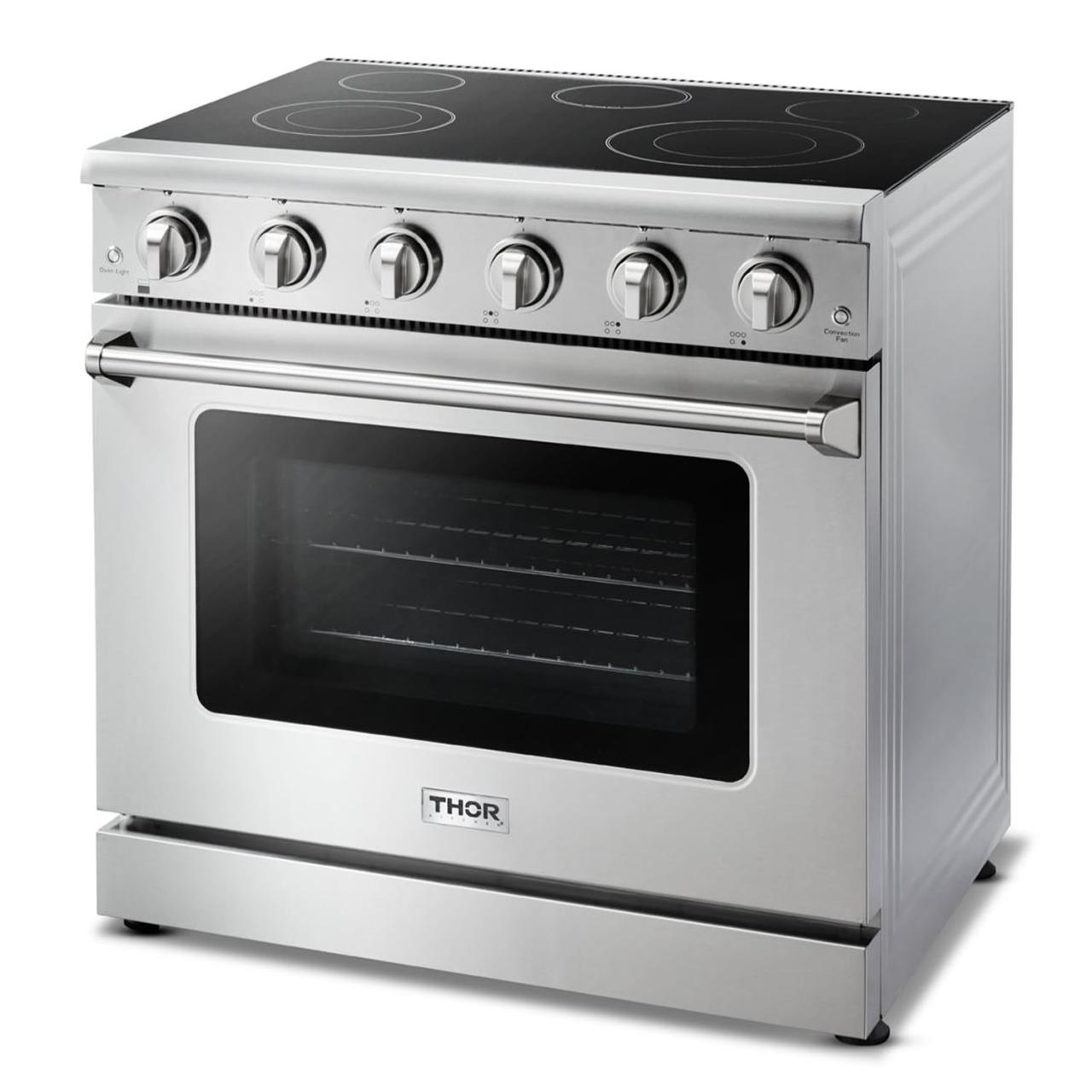The electric stove, once a fixture in kitchens across the globe, is undergoing a renaissance. Driven by advancements in technology and a growing focus on energy efficiency, electric stoves are no longer just a functional appliance – they are evolving into sophisticated cooking companions.
From the traditional coil top to the cutting-edge induction stove, there’s a wide array of options catering to different needs and preferences.
This guide delves into the world of electric stoves, exploring their diverse types, features, benefits, and safety considerations. We’ll equip you with the knowledge to make an informed decision when selecting the perfect electric stove for your kitchen, and provide insights into maximizing its performance for delicious and efficient cooking.
Types of Electric Stoves
Electric stoves are a popular choice for home kitchens, offering a variety of cooking options and features. They are known for their even heat distribution, ease of use, and safety. However, there are several types of electric stoves available, each with its own advantages and disadvantages.
This article will delve into the different types of electric stoves, including coil, smooth top, induction, and combination stoves, comparing their features, benefits, and drawbacks.
Coil Stoves
Coil stoves are the most traditional type of electric stove, featuring heating elements that are exposed and resemble coils. These coils heat up quickly and efficiently, making them ideal for boiling water or searing meat.
- Pros:Coil stoves are generally the most affordable option, and their exposed coils provide a visual indicator of heat levels. They are also very durable and can withstand high temperatures.
- Cons:Coil stoves can be slow to cool down, making it easy to accidentally burn food. They can also be difficult to clean, as food can get stuck between the coils and the surface.
Smooth Top Stoves
Smooth top stoves, also known as ceramic or glass top stoves, feature a smooth, flat surface made of glass or ceramic. These stoves use radiant heat to cook food, offering a more modern and sleek appearance than coil stoves.
- Pros:Smooth top stoves are easier to clean than coil stoves, as their smooth surface prevents food from sticking. They also heat up quickly and evenly, providing consistent cooking results.
- Cons:Smooth top stoves can be more expensive than coil stoves and are more susceptible to scratches and cracks. They also require special cleaning products to avoid damaging the surface.
Induction Stoves
Induction stoves use electromagnetic fields to generate heat directly in the cookware, rather than heating the cooking surface itself. This technology offers several advantages, including faster cooking times and greater energy efficiency.
- Pros:Induction stoves heat up quickly and cool down rapidly, reducing the risk of burns. They are also highly energy-efficient, as only the cookware is heated.
- Cons:Induction stoves require special cookware that is made of ferromagnetic materials, such as cast iron or stainless steel. They can also be more expensive than other types of electric stoves.
Combination Stoves
Combination stoves offer the best of both worlds, combining the features of two or more types of electric stoves. For example, a combination stove might feature a smooth top surface for one or two burners and coil burners for the remaining burners.
- Pros:Combination stoves provide versatility and flexibility, allowing you to choose the best cooking method for different dishes. They also offer the benefits of both types of stoves, such as the quick heating of coil burners and the ease of cleaning of smooth top burners.
- Cons:Combination stoves can be more expensive than single-type stoves and may require more maintenance due to their multiple components.
Features and Benefits of Electric Stoves
Electric stoves offer a range of features and benefits that make them a popular choice for modern kitchens. These features enhance cooking performance, safety, and energy efficiency, providing a compelling alternative to gas stoves.
Precise Temperature Control
Electric stoves excel in providing precise temperature control, a crucial factor for achieving consistent cooking results. Unlike gas stoves, where heat can fluctuate, electric stoves maintain a steady temperature, allowing for more accurate cooking. This is especially important for delicate recipes that require specific temperature ranges.
- Electronic controls: Electric stoves often feature electronic controls that allow for precise temperature adjustments in small increments. This enables cooks to fine-tune the heat to match specific cooking needs.
- Sensor technology: Some advanced electric stoves incorporate sensors that monitor the temperature of the cooking surface and automatically adjust the heat output to maintain the desired temperature. This eliminates the need for constant monitoring and ensures consistent cooking results.
Timer Settings
Electric stoves commonly include timer settings that enhance convenience and prevent overcooking. These timers allow cooks to set a specific cooking time and receive an alert when the food is ready. This feature is particularly useful for busy individuals or those who need to multitask in the kitchen.
- Automatic shut-off: Many electric stoves feature automatic shut-off functions that turn off the heating element when the timer reaches zero. This eliminates the risk of overcooking and potential fire hazards.
- Multiple timer settings: Some electric stoves offer multiple timer settings, allowing cooks to set different timers for different cooking tasks. This enables them to manage multiple dishes simultaneously.
Safety Features
Electric stoves are renowned for their safety features, making them a suitable choice for families with young children.
- Cool surface: Electric stoves have a cool surface around the heating elements, reducing the risk of burns. This is particularly important for families with young children who may be tempted to touch the stovetop.
- Automatic shut-off: The automatic shut-off feature mentioned earlier is a critical safety element, preventing accidents by turning off the heating elements when the timer reaches zero.
- Child lock: Some electric stoves come equipped with child locks that disable the stovetop controls, preventing accidental activation by children.
Consistent Heat Distribution
Electric stoves offer consistent heat distribution, ensuring even cooking results across the entire surface of the cooking element. This is achieved through the use of heating elements that are evenly spaced and designed to distribute heat uniformly.
- Radiant heating: Electric stoves typically use radiant heating elements, which emit heat directly onto the cookware. This method provides consistent heat distribution, unlike gas stoves, where heat can be uneven.
- Induction heating: Induction stoves, a type of electric stove, utilize electromagnetic fields to heat the cookware directly. This results in extremely efficient heat transfer and precise temperature control.
Ease of Cleaning
Electric stoves are generally easier to clean than gas stoves. The smooth, flat surface of an electric stovetop is less prone to spills and splatters, and the absence of open flames eliminates the risk of soot buildup.
- Smooth surface: The smooth surface of an electric stovetop is easily wiped clean with a damp cloth or sponge.
- Removable elements: Some electric stoves have removable heating elements that can be cleaned separately, making the cleaning process even easier.
Energy Efficiency
Electric stoves can contribute to a more energy-efficient kitchen. This is because electric stoves utilize energy more efficiently than gas stoves, particularly in terms of heat distribution and control.
- Precise temperature control: The precise temperature control offered by electric stoves minimizes energy waste by preventing overheating.
- Induction heating: Induction stoves are highly energy-efficient, converting almost all the energy used into heat, minimizing energy loss.
Choosing the Right Electric Stove
Selecting the ideal electric stove involves considering various factors, including your cooking needs, available space, and budget. A thoughtful approach ensures you invest in a stove that meets your requirements and enhances your culinary experience.
Understanding Cooking Zones and Power Levels
The cooking zones on an electric stove are designed for different types of cookware and cooking methods. Understanding their power levels helps you optimize cooking time and energy efficiency.
- Small Zones:Ideal for warming small pots or saucepans, these zones typically have lower power levels, ranging from 1,200 to 1,800 watts.
- Medium Zones:Designed for medium-sized pots and pans, these zones offer moderate power levels, usually between 1,800 and 2,400 watts.
- Large Zones:Suitable for large pots, woks, or griddles, these zones provide the highest power levels, often reaching 3,000 watts or more.
- Bridge Zones:Some stoves feature bridge zones, which combine two smaller zones to create a larger cooking area. These are useful for accommodating oversized cookware.
Factors to Consider When Choosing an Electric Stove
- Size:Consider the size of your kitchen and the available countertop space. Electric stoves come in various sizes, ranging from compact two-burner models to large five-burner stoves.
- Power:The total wattage of the stove indicates its overall power output. Higher wattage allows for faster heating and more intense cooking.
- Features:Modern electric stoves offer a range of features, including:
- Control Type:Knob controls offer simple operation, while touch controls provide a sleek and modern aesthetic.
- Timer:A timer allows you to set cooking times for hands-free operation.
- Keep Warm Setting:This feature keeps food warm after cooking, ideal for serving meals at a later time.
- Hot Surface Indicator:A visual indicator warns you when the cooking surface is hot, preventing accidental burns.
- Budget:Electric stoves come in a wide price range, depending on features, brand, and size. Set a realistic budget before shopping to narrow down your choices.
Popular Electric Stove Brands and Models
The following table compares some popular electric stove brands and models, highlighting their key features and specifications:
| Brand | Model | Number of Burners | Power (Watts) | Features | Price Range |
|---|---|---|---|---|---|
| GE | JGB720SELSS | 5 | 17,500 | Touch controls, timer, keep warm setting, hot surface indicator | $1,000
|
| Whirlpool | WGE545S0HS | 5 | 17,000 | Knob controls, timer, keep warm setting, hot surface indicator | $800
|
| Samsung | NE58F9510SS | 5 | 18,000 | Touch controls, timer, keep warm setting, hot surface indicator, bridge zone | $1,200
|
| LG | LRE3085ST | 4 | 14,000 | Knob controls, timer, keep warm setting, hot surface indicator | $700
|
Electric Stove Safety

Electric stoves offer convenience and efficiency in the kitchen, but they also require careful handling to prevent accidents. Understanding and implementing proper safety practices is crucial to ensure a safe cooking environment.
Safety Precautions When Using an Electric Stove
To ensure a safe cooking experience, it’s essential to follow specific safety precautions when using an electric stove.
- Never leave a hot stove unattended:Always supervise the stove while cooking, especially when using high heat or frying foods. A moment of distraction can lead to a fire or burn hazard.
- Keep flammable materials away:Avoid placing anything flammable, like paper towels or curtains, near the stove. Keep them at a safe distance to prevent accidental ignition.
- Use appropriate cookware:Choose cookware that is specifically designed for electric stoves. Using cookware that is not compatible with the stovetop can lead to uneven heating, potential damage to the stovetop, and increased risk of burns.
- Handle hot surfaces with care:Always use oven mitts or pot holders when handling hot cookware or touching the stovetop. Never touch the stovetop directly, even if it appears to be cool, as residual heat can cause burns.
- Turn off the stovetop after cooking:Always turn off the stovetop after finishing cooking. Even if you have a timer set, it’s important to check the stovetop to ensure that all elements are turned off.
- Keep cords away from the stovetop:Ensure that electrical cords for appliances, like blenders or coffee makers, are not draped over the stovetop or near the hot surface. This can pose a fire hazard.
Safety Features on Electric Stoves
Modern electric stoves often incorporate safety features to enhance user safety.
- Automatic shut-off:This feature automatically turns off the stovetop element after a predetermined time, preventing overheating and potential fires.
- Residual heat indicators:These indicators, usually in the form of a light or symbol, indicate that the stovetop element is still hot even after it has been turned off. This helps prevent accidental burns.
- Child locks:This feature prevents children from accidentally turning on the stovetop. It typically involves a lock or button that needs to be activated to enable the stovetop.
Cleaning and Maintaining Electric Stoves
Regular cleaning and maintenance are essential to keep your electric stove in good working condition and prevent safety hazards.
- Unplug the stove:Before cleaning, always unplug the stove from the power outlet to prevent electrical shock.
- Allow the stovetop to cool:Let the stovetop cool completely before attempting to clean it. This prevents burns and damage to the stovetop.
- Clean spills immediately:Clean up spills on the stovetop immediately. Sugar, food, or grease can scorch the stovetop if left unattended.
- Use a damp cloth:Use a damp cloth to wipe down the stovetop, removing any food residue or debris. Avoid using harsh chemicals or abrasive cleaners, as they can damage the stovetop surface.
- Clean the burner elements:Remove the burner elements and clean them with a damp cloth or a non-abrasive cleaner. Ensure that the elements are completely dry before reinstalling them.
- Clean the oven:Regularly clean the oven, including the interior walls, racks, and door. Use a non-abrasive cleaner and avoid using harsh chemicals. Follow the manufacturer’s instructions for cleaning the oven.
- Inspect the stovetop:Periodically inspect the stovetop for any signs of damage or wear. Replace any damaged components immediately.
Cooking Techniques on an Electric Stove

Electric stoves offer a unique cooking experience, requiring a slightly different approach compared to gas stoves. Understanding the nuances of electric stovetop cooking allows you to unlock its potential and achieve consistent, delicious results.
Understanding Heat Distribution
Electric stovetops generate heat through heating elements embedded beneath the cooking surface. This creates a more even and consistent heat distribution compared to gas stoves, which rely on open flames. However, the heat transfer is slower, meaning that preheating is crucial and sudden temperature changes should be avoided.
Choosing the Right Cookware
Selecting the right cookware is crucial for successful electric stovetop cooking. Flat-bottomed cookware ensures optimal contact with the heating element, facilitating even heat distribution. Heavy-bottomed pots and pans retain heat better, minimizing temperature fluctuations during cooking.
Mastering Temperature Control
Electric stoves typically offer a wider range of temperature settings than gas stoves. Understanding the specific temperature settings of your stovetop is crucial for achieving desired cooking results. For example, a low setting might be sufficient for simmering sauces, while a high setting is necessary for searing meats.
Tips for Successful Electric Stovetop Cooking
- Preheating:Preheating the stovetop for several minutes before adding food ensures even cooking and prevents sticking.
- Using the Right Setting:Choose the appropriate temperature setting for the dish you are preparing. Refer to your recipe or use a meat thermometer to ensure proper cooking.
- Adjusting Heat Gradually:Avoid sudden temperature changes as this can cause food to stick or burn. Instead, gradually increase or decrease the heat as needed.
- Monitoring Food:Keep a close eye on your food while cooking, as electric stovetops can be less responsive than gas stoves.
Tips for Browning
Achieving a beautiful, crispy brown crust on meat and vegetables is a hallmark of successful cooking. On an electric stovetop, this can be achieved by:
- Using a Cast Iron Pan:Cast iron pans retain heat exceptionally well, making them ideal for browning. Preheating the pan thoroughly before adding food is crucial.
- Avoiding Overcrowding:Overcrowding the pan prevents proper browning. Cook food in batches if necessary.
- Maintaining Heat:Avoid reducing the heat during browning, as this can lead to uneven cooking.
Tips for Simmering
Simmering is a gentle cooking method that allows flavors to meld and develop. On an electric stovetop, simmering requires:
- Low and Slow:Use a low heat setting to maintain a gentle simmer. Adjust the heat as needed to prevent the liquid from boiling.
- Using a Lid:A lid helps trap heat and moisture, promoting even simmering. However, leave the lid slightly ajar to allow steam to escape.
- Monitoring Liquid Levels:Monitor the liquid levels and add more as needed to prevent the food from burning.
Tips for Baking
Electric ovens provide consistent heat distribution, making them ideal for baking. To ensure successful baking results, consider:
- Preheating the Oven:Preheating the oven to the correct temperature is crucial for achieving proper rise and browning.
- Using the Right Baking Dish:Choose a baking dish that is appropriate for the recipe. Darker baking dishes absorb heat more readily, resulting in faster cooking times.
- Rotating the Dish:Rotate the baking dish halfway through the cooking time to ensure even baking.
Recipes for Electric Stoves
- Slow-Cooked Beef Stew:The slow, even heat of an electric stovetop is ideal for tenderizing tough cuts of beef.
- Creamy Risotto:The gentle heat of an electric stovetop allows you to slowly cook the rice grains, resulting in a creamy, perfectly cooked risotto.
- Perfectly Baked Chicken:The consistent heat distribution of an electric oven ensures even cooking, resulting in juicy, flavorful chicken.
Electric Stove Accessories

An electric stove is a versatile appliance that can be enhanced with various accessories to improve cooking efficiency and results. Choosing the right accessories can significantly impact your culinary experience, from preparing delicious meals to maintaining your stove’s longevity.
Cookware
Selecting the right cookware for your electric stove is crucial for achieving optimal heat distribution and cooking performance. The type of cookware you choose should be compatible with the heating elements of your stove.
- Cast iron cookwareis an excellent choice for electric stoves because it retains heat well, making it ideal for searing, roasting, and baking. Cast iron cookware can also be used on all types of stovetops, including induction. However, it requires proper seasoning to prevent rust and maintain its non-stick properties.
- Stainless steel cookwareis another popular option due to its durability and even heat distribution. Stainless steel cookware is also relatively easy to clean and can be used on various stovetops. However, it can be more challenging to achieve a perfect sear or browning compared to cast iron.
- Aluminum cookwareis a lightweight and affordable option that heats up quickly. However, aluminum cookware can be prone to warping or scratching, especially when exposed to high heat. It is also not suitable for all types of electric stoves, particularly induction stoves.
- Copper cookwareis known for its excellent heat conductivity and even cooking. However, copper cookware is expensive and requires careful maintenance. It is also not suitable for all types of electric stoves, especially induction stoves.
- Nonstick cookwareis ideal for cooking delicate foods that tend to stick, such as eggs or fish. However, nonstick cookware is often made with materials that can be damaged by high heat or abrasive cleaning agents. It is also not recommended for all types of electric stoves, particularly induction stoves.
Bakeware
Bakeware is essential for baking and roasting on your electric stove. The type of bakeware you choose will affect the outcome of your baked goods.
- Glass bakewareis a popular choice for baking because it is clear, allowing you to monitor the progress of your baking. Glass bakeware is also durable and can withstand high temperatures. However, glass bakeware can be prone to breakage and can be challenging to clean.
- Metal bakeware, such as aluminum or stainless steel, is another popular choice for baking. Metal bakeware is durable, affordable, and heats up quickly. However, metal bakeware can be prone to scorching or sticking, especially when baking delicate foods.
- Silicone bakewareis a flexible and non-stick option that is ideal for baking delicate foods. Silicone bakeware is also easy to clean and can be used in the oven, microwave, and freezer. However, silicone bakeware can be prone to tearing or melting at high temperatures.
Cleaning Supplies
Maintaining a clean electric stove is essential for ensuring its longevity and safety.
- Stovetop cleaneris specifically designed to remove grease, grime, and food stains from the surface of your electric stove. It is important to choose a cleaner that is safe for your stovetop material.
- Burner coversare designed to protect your electric stovetop from spills and splatters, making cleaning easier. They can be made from various materials, such as silicone, metal, or glass.
- Cleaning clothsare essential for wiping down your electric stove after each use. Microfiber cloths are a good choice because they are absorbent and lint-free.
The Future of Electric Stoves

The evolution of electric stoves is a testament to the constant pursuit of innovation and efficiency in the kitchen. From traditional coil elements to the advanced induction technology of today, electric stoves have consistently adapted to meet the evolving needs of modern cooks.
The future of electric stoves is brimming with exciting possibilities, driven by technological advancements and a growing emphasis on sustainability.
Smart Features and Connectivity
Smart features are rapidly transforming the way we interact with appliances, and electric stoves are no exception. These features offer enhanced control, convenience, and efficiency. Smart electric stoves can be controlled remotely via smartphone apps, allowing users to preheat ovens, adjust cooking temperatures, and monitor progress from anywhere.
Some models even integrate with voice assistants, enabling hands-free operation. The integration of smart features in electric stoves not only simplifies cooking but also contributes to a more connected and personalized kitchen experience.
Induction Technology Advancements
Induction technology has revolutionized electric cooking, offering faster heating times, precise temperature control, and enhanced energy efficiency. The future of induction cooking holds exciting advancements. One area of focus is the development of induction cooktops that can detect and adapt to different pot and pan sizes, ensuring optimal heating and energy usage.
Additionally, advancements in induction technology are exploring the potential for wider and more flexible cooking zones, allowing for greater versatility in the kitchen.
Energy-Efficient Designs
As concerns about energy consumption and sustainability grow, electric stove manufacturers are prioritizing energy-efficient designs. Advanced insulation techniques and optimized heating elements contribute to reduced energy usage, minimizing environmental impact. The development of innovative materials, such as ceramic glass cooktops, further enhances energy efficiency and durability.
The future of electric stoves is likely to see an increased focus on eco-friendly features, encouraging responsible cooking practices and reducing carbon footprint.
The Ideal Electric Stove of the Future
The ideal electric stove of the future will be a fusion of advanced technology, user-friendly design, and sustainable practices. It will seamlessly integrate smart features, offering remote control, voice activation, and personalized cooking profiles. Induction technology will be refined to deliver unparalleled precision and speed, while energy-efficient designs will minimize consumption and environmental impact.
The future electric stove will be a kitchen companion that adapts to individual needs, enhances cooking skills, and contributes to a more sustainable lifestyle.
End of Discussion

In a world where culinary innovation and technology intertwine, the electric stove stands poised to play a central role. As advancements continue to refine their performance, energy efficiency, and user experience, electric stoves are becoming a cornerstone of modern kitchens.
Whether you’re a seasoned chef or a budding home cook, understanding the nuances of electric stove technology can unlock a world of culinary possibilities, empowering you to create delectable dishes with ease and efficiency.

